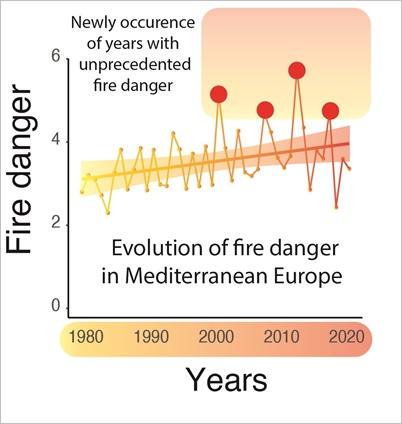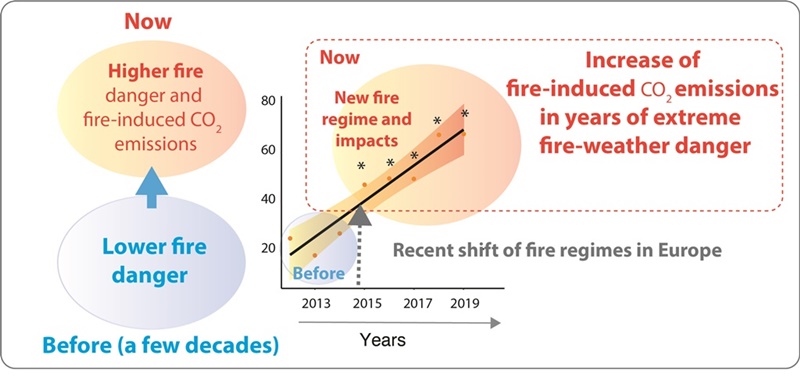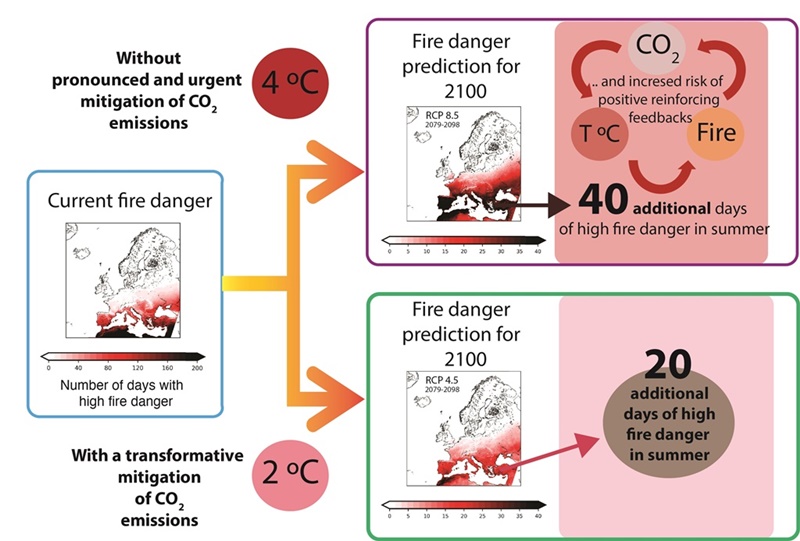Study reveals an unprecedented change in Europe’s fire regime
A study reveals an unprecedented change in the fire regime on the European continent, related to climate change. The affected areas are in Southern, Central and Northern Europe but this historical change in Europe’s fire regime is more intense in the Mediterranean area. The work, published on the journal Scientific Reports and called Global warming is shifting the relationships between fire weather and realized fire-induced CO2 emissions in Europe is directed by CREAF researcher Jofre Carnicer, who’s also professor of Ecology at the Faculty of Biology, and member of the Biodiversity Research Institute (IRBio) of the University of Barcelona.
Among the authors of the study are distinguished climatologists, experts on forest fire risks and forestry ecology, members of an international consortium of research institutions in which the UB, CREAF the Intergovernmental Panel on Climate Change (IPCC), the European Centre for Medium-Range Weather Forecasts (ECMWF), Institute for Environmental Research and Sustainable Development of the National Observatory of Athens, the European Space Agency (ESRIN-ESA), the University of Salento (Italy), and the University of Patras (Greece) –take part.
Spring and summer seasons with a high fire risk
The study detected summer and spring seasons with unprecedented values of fire risks over the last years, so many areas of southern Europe and the Mediterranean are reaching extreme conditions conducive to fires. These adverse conditions are becoming more frequent due to the increasing heatwaves and hydrological droughts.

“This increase in extreme fire risk is quite recent and at critical times it exceeds the fire-fighting capabilities of European societies, causing higher CO2 emissions associated with fire in extremely hot and dry summers”, notes Jofre Carnicer, first author of the study.

Forests and carbon sinks, threatened
For the first time, the work links the increased risk of fire with a higher number of CO2 emissions from fire and measured in satellite observations across the European continent. This phenomenon is occurring the Mediterranean Europe but also in the colder, northern and boreal Europe, which has important carbon sinks in the tundra and boreal forests.
The fire risk and impacts estimates based on meteorological data and satellite detection of fire impact have changed over time. This is the first time the recent increase in fire risks due to weather conditions is detected and it translates into a significative increase in fire-associated CO2 emissions in periods of extreme heat and danger of fires in summer.
“Forest and mountain areas in the southern and central Europe are the areas where the highest fire risks are detected”, notes Jofre Carnicer. “These areas are large carbon sinks that would be threatened by the fire, such as the Pyrenees, the Iberian and Cantabrian massifs in Spain, the Alps, the French central massif, the Italian Apennines in central Europe, the Carpathian Mountains, the Balkans, the Caucasus and the Pontic in the southeast area of Europe”.
The study provides continental maps of fire danger and predicts the evolution of the fire risk in Europe until 2100, through different trajectories of climate change (2ºC, 4ºC) and reduction of CO2 emissions.

“The conclusions suggest the fire regime could rapidly change in regions affected by climate change, such as the Mediterranean, Euro-Siberian and boreal areas of Europe”, notes the researcher.
“The most significant increase in fire risk will affect the areas in southern Europe that have forests and carbon sinks which are key for the regulation of climate”, says the expert, "Europe's forests absorb about 10% of total greenhouse gas emissions each year. Specifically, they capture around 360 million tons of CO2 per year, more than the emissions of a country like Spain, with a value around 214 million tons”.
The increase in fire risks described in the study is a challenge to the development and application of the new European Forestry Strategy, which proposes to maintain an annual reduction of at least 310 million tons of CO2 from the forestry and agricultural sectors by 2030 in Europe. As a consequence, the detected increase in fire risk could jeopardize decarbonization strategies based on forest and land uses if effective forest management strategies are not adopted to reduce these risks”, highlights Carnicer.

"Increased fire risk could fuel climate change, in cycles of increased warming and CO2 emissions from fire. Reducing CO2 emissions drastically in the next 2 decades (2030-2040) is key to lower fire risk, in Europe and globally!
Jofre Carnicer, researcher at CREAF
Jofre Carnicer is a member of the Intergovernmental Panel on Climate Change (IPCC) and of the National Committee for Climate in Spain (CNC). He is one of the authors of the Sixth Assessment Report by the Working Group II at IPCC, presented in February 2022, which revealed the impacts of climate change in the ecosystems and societies worldwide, the expected environmental and social risks for the upcoming decades, and the available adaption options to reduce the impact of climate change.
Reference article:
Carnicer, J.; Alegria, A.; Giannakopoulos, C.; Di Giuseppe, F.; Karali, A.; Koutsias, N.; Lionello, P.; Parrington, M.; Vitolo, C. Global warming is shifting the relationships between fire weather and realized fire-induced CO2 emissions in Europe. Scientific Report, June 2022.
DOI: 10.1038/s41598-022-14480-8







